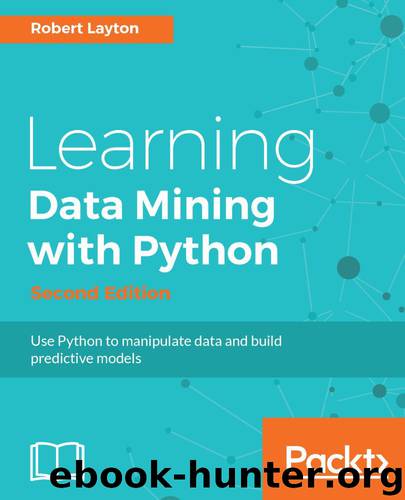Learning Data Mining with Python - Second Edition by Robert Layton

Author:Robert Layton [Layton, Robert]
Language: eng
Format: azw3
Tags: COM051360 - COMPUTERS / Programming Languages / Python, COM018000 - COMPUTERS / Data Processing, COM021030 - COMPUTERS / Databases / Data Mining
Publisher: Packt Publishing
Published: 2017-05-04T04:00:00+00:00
The difference in this graph compared to the previous graph is that the edges determine the similarity between the nodes based on our similarity metric and not on whether one is a friend of another (although there are similarities between the two!). We can now start extracting information from this graph in order to make our recommendations.
Finding subgraphs
From our similarity function, we could simply rank the results for each user, returning the most similar user as a recommendation - as we did with our product recommendations. This works, and is indeed one way to perform this type of analysis.
Instead, we might want to find clusters of users that are all similar to each other. We could advise these users to start a group, create advertising targeting this segment, or even just use those clusters to do the recommendations themselves. Finding these clusters of similar users is a task called cluster analysis.
Cluster analysis is a difficult task, with complications that classification tasks do not typically have. For example, evaluating classification results is relatively easy - we compare our results to the ground truth (from our training set) and see what percentage we got right. With cluster analysis, though, there isn't typically a ground truth. Evaluation usually comes down to seeing if the clusters make sense, based on some preconceived notion we have of what the cluster should look like.
Another complication with cluster analysis is that the model can't be trained against the expected result to learn—it has to use some approximation based on a mathematical model of a cluster, not what the user is hoping to achieve from the analysis.
Due to these issues, cluster analysis is more of an exploratory tool, rather than a prediction tool. Some research and applications use clustering for analysis, but its usefulness as a predictive model is dependent on an analyst selecting parameters and finding graphs that look right, rather than a specific evaluation metric.
Download
This site does not store any files on its server. We only index and link to content provided by other sites. Please contact the content providers to delete copyright contents if any and email us, we'll remove relevant links or contents immediately.
Sass and Compass in Action by Wynn Netherland Nathan Weizenbaum Chris Eppstein Brandon Mathis(13111)
Implementing Enterprise Observability for Success by Manisha Agrawal and Karun Krishnannair(8228)
Supercharging Productivity with Trello by Brittany Joiner(7476)
Mastering Tableau 2023 - Fourth Edition by Marleen Meier(7228)
Inkscape by Example by István Szép(7121)
Visualize Complex Processes with Microsoft Visio by David J Parker & Šenaj Lelić(6802)
Build Stunning Real-time VFX with Unreal Engine 5 by Hrishikesh Andurlekar(5828)
Design Made Easy with Inkscape by Christopher Rogers(5085)
Customizing Microsoft Teams by Gopi Kondameda(4631)
Business Intelligence Career Master Plan by Eduardo Chavez & Danny Moncada(4587)
Extending Microsoft Power Apps with Power Apps Component Framework by Danish Naglekar(4224)
Salesforce Platform Enterprise Architecture - Fourth Edition by Andrew Fawcett(4109)
Pandas Cookbook by Theodore Petrou(4086)
Linux Device Driver Development Cookbook by Rodolfo Giometti(4042)
The Tableau Workshop by Sumit Gupta Sylvester Pinto Shweta Sankhe-Savale JC Gillet and Kenneth Michael Cherven(3889)
Exploring Microsoft Excel's Hidden Treasures by David Ringstrom(3385)
TCP IP by Todd Lammle(3151)
Applied Predictive Modeling by Max Kuhn & Kjell Johnson(3037)
Drawing Shortcuts: Developing Quick Drawing Skills Using Today's Technology by Leggitt Jim(3032)
